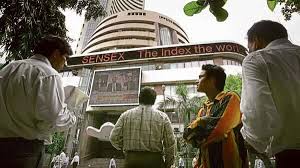http://sharetipsinfo.comJust get registered at Sharetipsinfo and earn positive returns

Topic :- Share Market Closing Note
The key benchmark indices bounced back with panache in opening trades this morning taking cues from the global peers. 
The S&P BSE benchmark index soared to a high of 58,435 in intra-day deals led by strong gains in IT major Infosys and the HDFC twins.
Infosys rallied over 5 per cent to a high of Rs 1,494 on the back of healthy Q2 performance and Rs 9,300 crore share buyback. Analysts expect the stock to log further gains in the coming trading sessions.
The key indices pared gains in the latter half of the trading sessions as the overall sentiment remained cautious in the backdrop of a high inflation scenario globally. The Sensex eventually ended 685 points higher at 57,920. Thanks to the Friday-rally, the BSE index was able to trim its weekly loss to 271 points.
The NSE Nifty 50 index rallied past the 17,300-level in early deals, but finally settled at 17,186 - up 171 points.
The broader indices erased the entire days gain towards the close. The BSE Midcap index was up 0.1 per cent, while the Smallcap index ended unmoved.
Sectorally, the BSE IT and Bankex surged 1.7 per cent each. The Capital Goods index was the other notable gainer. On the other hand, Oil & Gas and Power indices slipped over a per cent each.
The overall breadth was marginally positive, with 1,835 stocks advancing versus 1,608 declining shares on the BSE.
--------------------------------------------------------------------------------------------
Topic :- Time:3.05 PM
Nifty spot if holds above 17140 level on closing basis then expect some quick upmove in coming sessions and if it closes below above mentioned level then some sluggish movement can follow in the Nifty.
--------------------------------------------------------------------------------------------
Topic :- Time:3.00 PM
Just In:
India will be able to produce 25% of its oil demand by 2030, says Petroleum Minister
--------------------------------------------------------------------------------------------
Topic :- Time:12.30 PM
COPPER Trading View:
COPPER is trading at 662.15.If it breaks and trade below 661.80 level then expect some further decline in it and if it manages to trade and sustain above 663.20 level then some upmove can be seen in Copper.
--------------------------------------------------------------------------------------------
Topic :- Time:12.30 PM
Just In:
FEDERAL BANK Q2 : ST NET PROFIT AT 700 CR V 420 CR (YOY).
--------------------------------------------------------------------------------------------
Topic :- Time:12.00 PM
Nifty spot if manages to trade and sustain above 17360 level then expect some further upmove in the market and if it breaks and trade below 17300 level then some decline can follow in the Nifty.
--------------------------------------------------------------------------------------------
Topic :- Time:11.30 Am
News Wrap Up:
1. Sensex up 1,000 points; Infosys surges 5% post strong Q2
2. Anand Rathi Wealth hits record high, soars 8% on strong Q2 results
3. Singapore Airlines confirms Vistara-Air India merger discussions
4. Asian govts spent $50 bn in Sept to defend currencies from strong US dollar
5. India to become worlds third-largest economy by FY28, says IMF
6. Infosys does not support dual employment; have fired violators: Parekh
7. Sebi issues framework for dealing with suspension of rating agencies
8. In a first, Indias monthly mobile phone exports touched $1 bn in September
9. Russia warns of World War 3 if Ukraine joins Nato military alliance
10. Apollo Micro surges 10%; boards okays warrants issue up to Rs 185 crore
--------------------------------------------------------------------------------------------
Topic :- Nifty Opening Note
Indian Stock Market Trading View For 14 October 2022:
Nifty to trade volatile and is likely to follow global cues. Trade as per market trend.
Nifty spot if manages to trade and sustain above 17060 level then expect some upmove in the market and if it breaks and trade below 16940 level then some further decline can follow in the market.
Please note this is just opening view and should not be considered as the view for the whole day.
--------------------------------------------------------------------------------------------